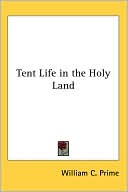

 |

|

The average rating for Tent Life in the Holy Land based on 2 reviews is 3 stars.
Review # 1 was written on 2018-01-16 00:00:00 Kelly Whisnant Kelly WhisnantThis book as great. Maybe it was just a timing thing - you know the right book at the right time, but this is one of the better Saudi desert books for me. The book came about because of the authors interest in Arab horses - he wanted to research the horses at the source for his book. Strangely, I don't think this is the book he was researching! There are some appendices, and one of which details the history, breeding, and nature of Arab horses, but the main body of the book is the pure experience and culture of the authors time with a number of different Bedouin tribes. His time with the Bedouin took place over a number of years in the early 1940s. At this time, by coincidence, there was a massive drought. This meant that the Bedouin were migrating in mass, a much larger migration than normal: P97 The multitude of the assembled tribe with its chattels and possessions had swelled to gigantic proportions. Nothing like it had happened for generations. The whole nation was in movement. This was not one of the ordinary migrations that take place in spring or autumn; rather was it one of the historic tribal crusades that occur once in a generation, or century. In their hundreds of thousands, grunting camels swarmed over the face of the wilderness. their long necks rose and fell rhythmically. They undulated and flowed on as if they were carried forward by some invisible movement of the ground. Like locusts, they looted the scanty greyish-green pasture before their hungry mouths. Not a trace of vegetation survived their passage. They left nothing behind but naked, trampled earth and over it a veil of dust and mist that hung in the still air for hours. and p87 The whole desert basin was alive and thronging with herds moving in one great heaving mass. There arose the confused din of more than three hundred thousand animals which for miles around spread a penetrating musk-like smell. Apart on the flaks of the main mass, were the pack-camels, laden with tents, equipment, provisions, and so forth, under the guard of their drivers. Raswan travels Bedouin style, no additional luxuries, and little special treatment, although he becomes close friends with the leaders of the tribes he travels with. Initially with the Ruala tribe, he makes the migration with them. Without giving too much away, they hunt, they starve, they suffer, the make make raids and get raided. It is a life of danger and trust, and the making of quick decisions. After some time with the Ruala he travels to visit another tribe in their grazing grounds, spending a little time with various tribes on the way. As I mentioned above there are some very scholarly appendices, covering such topics as: The Arab an his Horse, Bedouin Tribes of Arabia, Explanations of the three Maps, Tribal Descent of Arabian Bedouins and a Glossary. Not being a horse aficionado, he baffled me with his in depth descriptions of the traits of the different strains of Arab horse, there were technical terms, diagrams of legs and things. The basic premise however is that all Arab horses derive from three strains: (P201) 1. The "KUHAYLAN" representing strength and the primeval or original type, the blue-blood of Arabia - and ideal saddle and cavalry horse, powerful, muscular and of great endurance. Even the mares of teh Kuhaylan strain are of masculine appearance. 2. The 'SAQLAWI' representing beauty,and the refined, elegant type, the elite horses of Arabia, the most showy and by far the most handsome of all animals. Even the stallions of the Saqlawi strain are of feminine appearance. 3. The "MU'NIQI" representing speed and the double of the English thoroughbred and indeed its most important ancestor. The Mu'niqi have long lines: they are lean, taller than the others, and very rarely do they possess those certain Arabian features which we find so distinctive in the Kuhaylan and Saqlawi strains. The Mu'niqi are the race or running type. Great reading - five stars no question. |
Review # 2 was written on 2019-11-03 00:00:00 Marcus Goodrich Marcus GoodrichRead once, twice and keep to consult. A marvellous account of the life and times of the Bedouin population in the early 20thC . Written by one of a few truly ardent enthusiasts of the Arabian Horse. Some have said Raswan's account is romanticised. perhaps so. Well look at what he was doing, why and where it all took place. His accounts of horse bloodline record-keeping, the lifestyles and habits, even with some embellishment, has to have a place on the bookshelves of travel, cultural or Arabian horse enthusiasts. My edition is far older than any on offer here! 1935 when it was published twice such was the appetite for information on exotic adventure travel and The Arabian Horse. I will put a date...but truly, this is a book to read many times. |
CAN'T FIND WHAT YOU'RE LOOKING FOR? CLICK HERE!!!